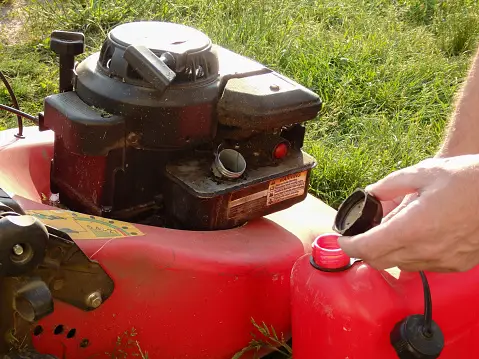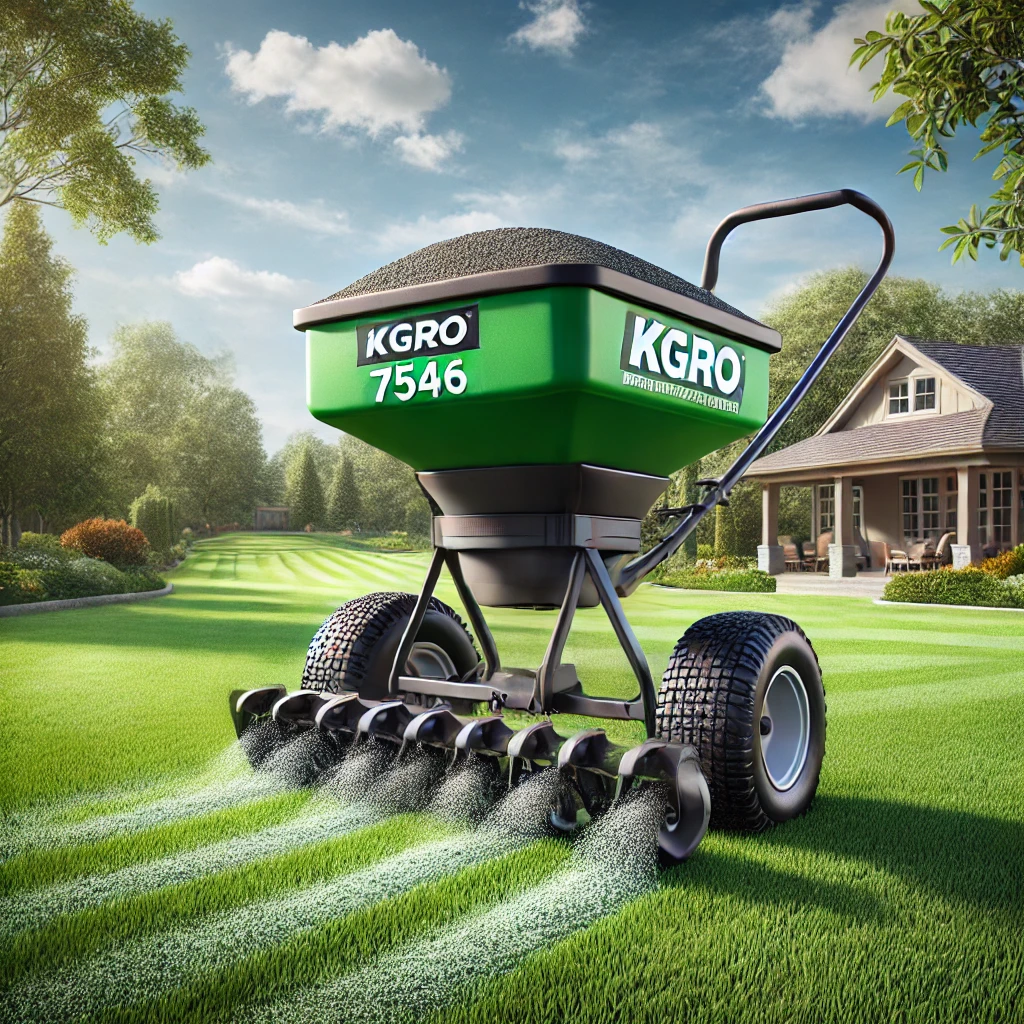Introduction
Maintaining a lawn mower is crucial not only to extend its lifespan but also to ensure its efficiency and reliability throughout its use. Much like any machinery with a combustion engine, lawnmowers require proper care, with particular attention paid to the quality and condition of the fuel used. Over time, fuel can degrade, leading to a host of engine problems that can impair function or even lead to costly repairs.
Gas stabilizers play a vital role in this maintenance regimen. These additives are designed to preserve the integrity of the fuel stored in your lawn mower’s tank, especially during extended periods of non-use, such as the winter months.
By using a gas stabilizer, you can significantly reduce the risk of fuel degradation, which in turn helps maintain the mower’s engine in optimal condition. This is crucial because stale fuel is one of the leading causes of engine start-up issues and poor performance in lawnmowers.
Understanding Gas Stabilizers
Gas stabilizers are chemical solutions that, when added to fuel, help extend the fuel’s shelf life and prevent the chemical breakdown that leads to varnish and gum deposits in the engine. These stabilizers work by inhibiting the oxidation process and moisture absorption in the fuel. Oxidation is a natural chemical reaction that occurs between gasoline and oxygen, leading to the formation of substances that can clog the engine’s carburetor and fuel passages.
The chemistry behind gas stabilizers involves a mixture of antioxidants, corrosion inhibitors, and metal deactivators which together create a protective barrier around fuel molecules. This barrier not only prevents the fuel from undergoing oxidative reactions but also keeps moisture from condensing inside the fuel tank.
By doing so, gas stabilizers ensure that the fuel remains fresh, combustible, and free from harmful deposits, thus aiding in smoother ignition, better fuel efficiency, and overall enhanced performance of the lawn mower’s engine.
This foundational understanding of gas stabilizers underscores their importance in lawn mower maintenance and highlights how they are a simple yet effective tool in extending the life and performance of your garden equipment.
Why Use Gas Stabilizers in Lawn Mowers?

Lawnmowers, especially those that sit idle through seasons when they are not in use, face a series of potential issues that can impair their functionality and longevity. Gas stabilizers address these concerns directly by preserving the quality of the fuel, which is fundamental to the health of the lawn mower’s engine.
Common issues with lawn mower engines when unused for long periods include the degradation of fuel, which can lead to the formation of varnish and gum in the engine. This gumming up of the engine can cause the carburetor to clog and the fuel filters to become obstructed, which often results in hard starting, rough running, and even engine failure. Furthermore, old fuel can cause corrosion within the fuel system, damaging the carburetor, and fuel lines, and potentially leading to expensive repairs.
The role of gas stabilizers in preserving fuel and engine health is therefore pivotal. By adding a gas stabilizer to the fuel tank before a period of storage, you create a protective layer that prevents the fuel from oxidizing and moisture from accumulating. This action significantly reduces the risk of gum and varnish build-ups.
Moreover, stabilizers contain corrosion inhibitors that protect vital engine components from rust and corrosion. This dual action of chemical stabilization and moisture control helps maintain the engine in pristine condition, ensuring that the lawn mower is ready to operate smoothly once it’s taken out of storage.
In essence, using gas stabilizers is a preventative measure that saves time, money, and effort in maintenance. It ensures that when it’s time to mow the lawn again, your equipment will start easily and run efficiently, thereby extending the overall lifespan of your lawn mower.
Types of Gas Stabilizers
Gas stabilizers come in various formulations and brands, each designed to cater to specific needs and types of equipment. Choosing the right stabilizer can enhance the performance and longevity of your lawn mower, making understanding the different types available essential.
Overview of different brands and formulations:
- Ethanol Blends: Many gas stabilizers are formulated specifically to combat the negative effects of ethanol in gasoline, which is common in many regions. Ethanol attracts moisture, which can lead to water contamination in your fuel. Brands like Sta-Bil and Sea Foam offer products specifically designed to protect against ethanol-induced problems, preserving the fuel integrity and engine components.
- Multi-Functional Stabilizers: Products such as Lucas Oil fuel stabilizers not only preserve fuel but also clean and lubricate the fuel system. These stabilizers are great for those looking for an all-in-one solution to maintain their lawn mower’s engine.
- Seasonal Formulations: Some stabilizers are formulated for seasonal use, such as those tailored for winter storage. These often contain additional corrosion inhibitors to protect the engine during cold, damp conditions when mowers are most vulnerable to damage.
Pros and cons of each type based on usage and efficiency:
- Ethanol Blends:
- Pros: Effective at preventing moisture-related issues, particularly useful in areas where ethanol-blended fuels are common. They help prevent phase separation, a common problem with ethanol fuels.
- Cons: Some may not provide comprehensive cleaning benefits or lubrication, focusing solely on moisture control.
- Multi-Functional Stabilizers:
- Pros: Offer a comprehensive solution by cleaning, lubricating, and stabilizing the fuel. This can improve overall engine performance and fuel efficiency.
- Cons: Often more expensive than basic stabilizers, and the additional chemicals may not be necessary for all types of lawn mowers.
- Seasonal Formulations:
- Pros: Tailored to protect during specific conditions like winter, providing peace of mind through long storage periods.
- Cons: Limited use outside of their specific season; purchasing different stabilizers for different seasons can be costly.
Understanding these differences and choosing the right gas stabilizer can greatly impact the effectiveness of your lawn mower’s maintenance regime. Whether you prioritize moisture control, engine cleaning, or seasonal protection, there is a stabilizer designed to meet your needs.
How to Use Gas Stabilizers
Using gas stabilizers correctly is key to maximizing their benefits and ensuring your lawn mower operates efficiently after prolonged storage. Here is a step-by-step guide on how to add stabilizers to your lawn mower fuel, along with best practices for fuel storage.
Step-by-Step Guide on Adding Stabilizers to Lawn Mower Fuel:
- Purchase the Appropriate Stabilizer: Choose a gas stabilizer that suits your lawn mower and the type of fuel you use. Pay attention to whether the stabilizer is suitable for ethanol-blended fuels if applicable.
- Read the Instructions: Before proceeding, carefully read the instructions on the stabilizer packaging. Different brands and types might have specific mixing ratios.
- Prepare Your Mower: Ensure your lawn mower’s fuel tank is nearly empty by running the mower until it’s almost out of fuel. This reduces the old gasoline in the tank.
- Mix the Stabilizer: If your stabilizer needs to be mixed with fuel before being added to the tank, do so according to the instructions. Typically, you will add the stabilizer to a container of gasoline.
- Fill the Tank: Pour the stabilized fuel into the mower’s fuel tank. Fill the tank to the top to minimize the air space in which condensation can occur, which can introduce water into the fuel.
- Run the Mower: Start the lawn mower and let it run for a few minutes. This allows the stabilized fuel to circulate through the carburetor and the fuel system, ensuring all components are protected.
Best Practices for Fuel Storage with Stabilizers:
- Store in a Cool, Dry Place: Keep your fuel container in a cool, dry place away from direct sunlight to prevent the fuel from degrading due to heat and light exposure.
- Use Clean, Airtight Containers: Store stabilized fuel in clean, airtight containers to protect it from moisture and air exposure. This helps maintain fuel quality over time.
- Label and Date Your Containers: Always label your fuel containers with the date you added the stabilizer and the type of fuel. This is helpful for tracking the usability period, as most stabilized fuel can be stored for up to 24 months.
- Regularly Check the Fuel: Before using your lawn mower, check the condition of the fuel. If it smells stale or looks cloudy, it might be best to dispose of it safely and refill it with fresh stabilized fuel.
Following these steps and best practices will ensure that your lawn mower’s fuel remains fresh and ready for use, preventing common fuel-related issues and maintaining your equipment in optimal condition.
Benefits of Using Gas Stabilizers for LawnMowers
Extended Fuel Life and Reduced Need for Engine Repairs: Using gas stabilizers in your lawn mower offers significant benefits in terms of fuel longevity and engine maintenance. By preventing the oxidation and degradation of fuel, stabilizers extend the usable life of the gasoline stored in your mower’s tank.
This not only saves money by reducing the frequency of fuel replacements but also decreases the likelihood of engine problems caused by bad fuel. Fewer engine issues translate into lower repair costs and less downtime for maintenance, allowing your mower to perform at its best whenever it’s needed.
Improvement in Engine Performance and Reliability: Regular use of gas stabilizers ensures that the fuel in your lawn mower remains clean and efficient, leading to smoother starts and more consistent engine performance.
Stabilized fuel helps maintain the cleanliness of the carburetor and fuel injectors, promoting better combustion and more efficient operation. This reliability is crucial for extending the lifespan of the engine and ensuring that your lawn mower is always ready for work, providing peace of mind and enhanced usability.
Choosing the Right Gas Stabilizer
Factors to Consider When Purchasing a Stabilizer:
- Compatibility: Ensure the stabilizer is suitable for the type of fuel used in your lawn mower, particularly if it’s ethanol-blended fuel. Compatibility affects the effectiveness of the stabilizer in preventing fuel degradation.
- Cost: Consider the cost-effectiveness of different stabilizers. Some may be more expensive but offer additional benefits such as cleaning agents or corrosion inhibitors that can save money on maintenance in the long run.
- Longevity: Check how long the stabilizer will keep the fuel fresh. Most stabilizers claim to maintain fuel stability for anywhere from one to two years. Choose one that offers the longest protection within your typical usage patterns.
Recommendations for Top-Rated Gas Stabilizers Currently on the Market:
- STA-BIL Storage Fuel Stabilizer: Widely recognized for its effectiveness, STA-BIL is suitable for all gasoline engines, including two-cycle mixtures. It’s particularly praised for its ability to preserve fuel for up to 24 months, making it ideal for seasonal equipment like lawnmowers.
- Sea Foam Motor Treatment: Not only does this product stabilize fuel, but it also cleans and lubricates the engine’s moving parts. It’s a great all-around choice for maintaining engine health and fuel quality.
- Lucas Oil Fuel Stabilizer: A reliable choice for those who need both a fuel preservative and a solution that helps neutralize low-quality gasoline. It’s especially effective in preventing fuel degradation and the resultant deposits in the fuel system.
Choosing the right gas stabilizer can significantly enhance the performance and longevity of your lawn mower, ensuring it remains a reliable tool for maintaining your garden.
Best Fuel Stabilizer for Lawn Mower
Choosing the best fuel stabilizer for your lawn mower is crucial to ensuring its longevity and optimal performance. The right stabilizer can help prevent fuel degradation during periods of non-use and maintain the engine in prime condition. ‘
Here are some of the top-rated fuel stabilizers on the market, known for their effectiveness in protecting lawn mower engines:
1. STA-BIL Storage Fuel Stabilizer
- Features: STA-BIL Storage is specifically designed to protect against rust and corrosion while keeping fuel fresh for up to 24 months. It is effective in all gasoline, including ethanol blends.
- Benefits: Prevents fuel oxidation and varnish and gum buildup. STA-BIL is particularly recommended for long-term storage, making it ideal for winterizing lawnmowers.
- User Reviews: Widely praised for its reliability and effectiveness, users report that lawnmowers treated with STA-BIL start effortlessly after being stored for extended periods.
2. Sea Foam Motor Treatment
- Features: Sea Foam is a versatile product that acts as a fuel stabilizer, cleaner, and moisture controller. It can be used in both gas and diesel engines.
- Benefits: Cleans and lubricates the engine’s fuel system, helps to stabilize stored fuel for up to two years, and reduces moisture in fuel systems.
- User Reviews: Users love Sea Foam for its ability to rejuvenate old gasoline and improve the start-up performance and overall efficiency of lawn mowers.
3. Lucas Oil Fuel Stabilizer
- Features: Lucas Oil is known for its high-quality automotive products, and its fuel stabilizer is no exception. It is safe to use with all types of gasoline and is great for preventing gasoline breakdown during storage.
- Benefits: Protects the fuel system from rust, increases the fuel’s lifespan, and prevents varnish and gum formation.
- User Reviews: Lawnmower owners appreciate Lucas Oil for its ability to extend the life of the fuel, particularly in climates where frequent fuel changes are necessary due to varying temperatures.
4. Briggs & Stratton Advanced Formula Fuel Treatment & Stabilizer
- Features: This stabilizer is formulated by one of the leading manufacturers of lawn mower engines, ensuring compatibility and effectiveness.
- Benefits: Provides triple antioxidant protection, cleans and protects engine parts, and extends the life of the fuel up to three years.
- User Reviews: Highly regarded by users for its effectiveness in enhancing engine performance and making startup quick and easy after storage.
Each of these stabilizers offers unique benefits, so the best choice will depend on your specific requirements, such as the frequency of use, storage duration, and local fuel types. Consider these factors alongside the stabilizer features to choose the most suitable product for your lawn mower.
How Much Fuel Stabilizer For the Mower

The amount of fuel stabilizer you should use for your lawn mower depends on the specific product you choose, as different brands and formulations may require varying amounts. However, here are some general guidelines and steps to determine the correct amount of stabilizer for your lawn mower:
General Guidelines
Most fuel stabilizers provide instructions on the correct ratio of stabilizer to fuel. Typically, this ratio ranges from 1 ounce (about 30 mL) of stabilizer for every 2.5 gallons (approximately 9.5 liters) of fuel to 1 ounce per gallon (about 3.8 liters) of fuel. It’s crucial to follow the specific instructions on the product’s label for the best results.
Steps to Determine the Correct Amount
- Check the Label: Look at the instructions on the stabilizer’s packaging. The manufacturer will specify the amount needed per volume of fuel.
- Measure Your Mower’s Fuel Capacity: Determine the fuel capacity of your lawn mower, which is usually listed in the owner’s manual. Knowing the full capacity will help you calculate how much stabilizer is needed for a full tank.
- Calculate the Amount of Stabilizer: Use the ratio provided on the stabilizer label to calculate the amount needed for your mower’s tank size. For example, if your mower holds 2 gallons of fuel and the stabilizer requires 1 ounce for every 2.5 gallons, you would use about 0.8 ounces of stabilizer.
- Mixing: If you’re preparing to store your mower, it’s a good idea to mix the stabilizer with the fuel in a separate container first. This ensures the stabilizer is thoroughly mixed with the fuel before you add it to the mower’s tank.
- Run the Mower: After adding the stabilized fuel to the tank, run the mower for a few minutes. This helps distribute the stabilized fuel throughout the fuel system, ensuring that all parts are protected during storage.
By following these guidelines, you can effectively use a fuel stabilizer in your lawn mower to maintain the quality of the fuel and ensure that your mower remains in good running condition, especially during periods of storage.
Sta-Bil Fuel Stabilizer
STA-BIL Fuel Stabilizer is a popular and highly regarded brand in the realm of fuel additives, particularly known for its effectiveness in preserving fuel quality and prolonging engine life.
It is widely used in various types of engines and is especially beneficial for equipment that may sit idle for extended periods, such as lawn mowers, boats, and motorcycles. Here’s an in-depth look at STA-BIL Fuel Stabilizer:
Features of STA-BIL Fuel Stabilizer
- Prevention of Fuel Degradation: STA-BIL is designed to prevent the breakdown of gasoline, which can happen when fuel is stored for more than 30 days. It stabilizes fuel for up to 24 months, preventing the formation of varnish and gum in the fuel system.
- Protection Against Corrosion: STA-BIL also includes ingredients that protect the fuel system from rust and corrosion, which are common issues in engines that undergo seasonal storage.
- Compatibility: It is safe for use in all gasoline engines, including those that are ethanol-blended. This makes it versatile for almost any type of gas-powered equipment.
How to Use STA-BIL Fuel Stabilizer
- Determine the Amount Needed: The typical mixing ratio recommended by STA-BIL is 1 ounce (30 mL) of stabilizer per 2.5 gallons (9.46 liters) of fuel. This ratio can stabilize and protect the fuel for up to 24 months.
- Add STA-BIL to Fuel: For best results, add STA-BIL to fresh fuel. If you are filling up a gas can, add STA-BIL before filling the can to ensure thorough mixing.
- Run the Engine: After adding STA-BIL to the fuel, run the engine for a few minutes. This ensures that the stabilized fuel circulates throughout the fuel system and reaches all components, offering full protection.
Benefits of Using STA-BIL Fuel Stabilizer
- Extended Storage: STA-BIL is ideal for seasonal storage, ensuring that your engine starts smoothly after being idle without needing to drain the fuel system.
- Ease of Maintenance: By preventing fuel deterioration and the resulting deposits, STA-BIL reduces the need for carburetor and fuel system maintenance.
- Economical: Using STA-BIL can save money by avoiding the costs associated with engine problems due to poor or degraded fuel.
Common Applications
- Lawn Mowers: Perfect for winterizing or any time the mower will not be used for 30 days or more.
- Motorcycles and Boats: Helps keep fuel systems clean during the off-season.
- Classic Cars: Ideal for vehicles that are not driven frequently, ensuring that they run smoothly when taken out for a spin.
STA-BIL Fuel Stabilizer is a trusted choice among many engine owners for its reliable protection against the problems associated with stored fuel. Whether you’re preparing your lawn mower for winter or looking to maintain the performance of any seasonal equipment, STA-BIL offers a practical solution to keep your engines in excellent condition.
Should I Use a Fuel Stabilizer In My Lawn Mower
Yes, you should consider using a fuel stabilizer in your lawn mower, especially if you plan to store it for an extended period or use it infrequently. Here are some key reasons why incorporating a fuel stabilizer can be beneficial:
Prevention of Fuel Degradation
Fuel in your lawn mower can degrade over time if it sits unused. This degradation can lead to the formation of varnish and gum deposits within the engine’s fuel system, which can clog the carburetor and fuel lines, causing poor performance or difficulties in starting the engine. A fuel stabilizer prevents these deposits by keeping the fuel fresh for longer periods.
Ease of Maintenance
Using a fuel stabilizer simplifies the maintenance of your lawn mower. By maintaining fuel quality, the stabilizer reduces the need for frequent carburetor cleanings and overhauls. This can significantly decrease maintenance costs and effort over time.
Extended Storage
If you typically put away your lawn mower for the winter or another off-season, adding a stabilizer to the fuel before storage can help ensure that the mower will start easily when it’s next used. This is particularly important in regions with seasonal changes where mowers may not be used for several months at a time.
Protection Against Ethanol
Many modern fuels contain ethanol, which can attract moisture that leads to fuel system corrosion and other issues. A stabilizer can help protect against these ethanol-related problems by preventing water from accumulating in the fuel system.
Read more about what type of oil goes in a lawn mower
How to Use Fuel Stabilizer in Lawn Mower
Using a fuel stabilizer in your lawn mower is a straightforward process that can help preserve the quality of the fuel and protect the engine during periods of storage. Here’s a step-by-step guide on how to use a fuel stabilizer effectively:
- Choose the Right Stabilizer: Select a fuel stabilizer that is compatible with the type of fuel used in your lawn mower. Check the label or manufacturer’s instructions for compatibility information.
- Prepare the Fuel Tank: If your lawn mower has fuel remaining in the tank, consider running the engine until the tank is nearly empty. Alternatively, you can drain the existing fuel from the tank if it’s old or contaminated.
- Mix the Stabilizer: Refer to the instructions provided by the manufacturer to determine the correct amount of stabilizer needed for the volume of fuel in your mower’s tank. Typically, you’ll add a certain amount of stabilizer per gallon or liter of fuel.
- Add the Stabilizer to the Fuel: Pour the appropriate amount of stabilizer directly into the fuel tank of your lawn mower. If you’re uncertain about the correct dosage, it’s better to err on the side of caution and slightly underdose rather than overdose the stabilizer.
- Fill the Tank with Fresh Fuel: After adding the stabilizer, fill the remainder of the fuel tank with fresh gasoline. Using fresh fuel helps ensure that the stabilized mixture is of high quality and ready for use.
- Run the Engine: Start the lawn mower and let it run for a few minutes. This allows the stabilized fuel to circulate through the fuel system, including the carburetor and fuel lines, ensuring that all components are protected.
- Store the Lawn Mower: If you’re preparing the lawn mower for storage, ensure that it is stored in a cool, dry place away from direct sunlight. This helps prevent fuel evaporation and degradation during storage.
By following these steps, you can effectively use a fuel stabilizer in your lawn mower to maintain fuel quality and protect the engine, especially during periods of storage or infrequent use. Regular use of a fuel stabilizer can help ensure that your lawn mower starts easily and operates smoothly whenever you need it.
Fuel Stabilizer For Lawn Mower Home Depot
You can find a variety of fuel stabilizers for lawnmowers at Home Depot, both in-store and online. Home Depot offers a range of trusted brands and formulations to suit your specific needs and preferences. Here are some popular fuel stabilizers that you may find at Home Depot:
- STA-BIL Storage Fuel Stabilizer: STA-BIL is a well-known brand that offers effective fuel stabilization for lawnmowers and other small engines. Their Storage Fuel Stabilizer is designed to protect against corrosion, varnish, and gum buildup, ensuring that your mower starts easily after periods of storage.
- Lucas Oil Fuel Stabilizer: Lucas Oil is another reputable brand that offers a high-quality fuel stabilizer suitable for lawnmowers. Their stabilizer helps prevent fuel oxidation and extends the life of stored fuel, making it an excellent choice for seasonal equipment.
- Briggs & Stratton Advanced Formula Fuel Treatment & Stabilizer: Briggs & Stratton, a leading manufacturer of small engines, offers a fuel treatment and stabilizer specifically formulated to protect against ethanol-related issues. Their product helps keep fuel fresh for up to three years, making it ideal for long-term storage.
- Star Tron Enzyme Fuel Treatment: Star Tron’s Enzyme Fuel Treatment is a versatile option that not only stabilizes fuel but also enhances fuel combustion and engine performance. It is compatible with all gasoline engines, including those with ethanol-blended fuel.
You can purchase these fuel stabilizers at your local Home Depot store or conveniently order them online for home delivery or in-store pickup. Be sure to check the product specifications and customer reviews to find the best fuel stabilizer for your lawn mower’s needs.
Conclusion
In conclusion, using a fuel stabilizer in your lawn mower is a simple yet effective way to maintain fuel quality, protect the engine, and ensure reliable performance, especially during periods of storage or infrequent use. By adding a stabilizer to the fuel, you can prevent fuel degradation, corrosion, and varnish buildup, ultimately reducing the need for costly repairs and maintenance.
Whether you’re preparing your lawn mower for the winter months or simply looking to prolong its lifespan and efficiency, incorporating a fuel stabilizer into your maintenance routine is highly recommended. With a wide range of options available, including trusted brands like STA-BIL, Lucas Oil, and Briggs & Stratton, you can easily find a stabilizer that meets your specific needs and preferences.
By following the recommended dosage and usage instructions, you can effectively protect your lawn mower’s engine and ensure that it starts easily and runs smoothly whenever you need it. Make it a habit to use a fuel stabilizer in your lawn mower, and enjoy the peace of mind knowing that your equipment is well-maintained and ready for action whenever you are.
Frequently Asked Questions
Q: How often should I add a gas stabilizer to my lawn mower?
A: It’s best to add a stabilizer each time you refuel, especially if you do not expect to use all the fuel within 30 days. For prolonged storage, like over the winter, add a stabilizer to the fuel before storing the mower.
Q: Can I use any type of gas stabilizer for my lawn mower?
A: Not all stabilizers are suitable for every type of fuel. Check whether the stabilizer is compatible with your mower’s fuel type, particularly if you’re using ethanol-blended fuels.
Q: What should I do if my mower still doesn’t start after using a stabilizer?
A: If your lawn mower doesn’t start after being stored with stabilized fuel, check other potential issues like spark plug failure, carburetor clogs, or battery problems in electric-start models. It might be necessary to clean or replace these components.
Q: Does the brand of gas stabilizer matter?
A: While brand preference can vary, it is important to choose a stabilizer that has good reviews and is recommended for the type of fuel used in your mower. High-quality brands like STA-BIL, Sea Foam, and Lucas Oil are generally reliable and effective.
By addressing these common queries and following the provided tips for troubleshooting, you can enhance your understanding and management of fuel-related issues in lawnmowers. Regular use of gas stabilizers is a proactive step toward efficient and trouble-free lawn mower operation.
Can I use a gas stabilizer in my lawn mower?
Yes, you can and should use a gas stabilizer in your lawn mower, especially if you do not plan to use all the fuel quickly or if you intend to store the mower for an extended period (e.g., over the winter). A gas stabilizer will help keep the fuel fresh, prevent degradation, and ensure that your mower starts easily and runs well when you need it.
How much stabilizer do I put in my lawn mower?
The amount of stabilizer needed depends on the volume of fuel and the specific instructions provided by the stabilizer manufacturer. Typically, you will find a recommended ratio on the packaging of the stabilizer, such as one ounce of stabilizer per two and a half gallons of fuel. Always follow the manufacturer’s guidelines to ensure optimal results.
What is the best gas treatment for lawnmowers?
The best gas treatment for lawnmowers will depend on your specific needs, but popular and highly rated options include STA-BIL Fuel Stabilizer, Sea Foam Motor Treatment, and Lucas Oil Fuel Stabilizer. These treatments are effective at preserving fuel, cleaning the fuel system, and enhancing engine performance.
Is a gas stabilizer necessary?
While not absolutely necessary, using a gas stabilizer is highly recommended for maintaining your lawn mower’s engine health. Gas stabilizers prevent fuel from oxidizing and deteriorating, which can lead to engine problems and costly repairs. If you plan to store fuel in your mower for more than 30 days, using a stabilizer can help ensure the engine starts easily and runs smoothly when next used.
These answers provide clear guidance on the benefits and practical use of gas stabilizers in lawnmowers, helping you to maintain your equipment in optimal condition.
Like this:
Like Loading...













Leave a Reply